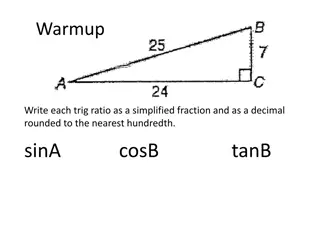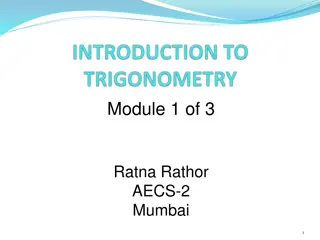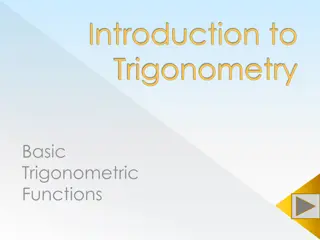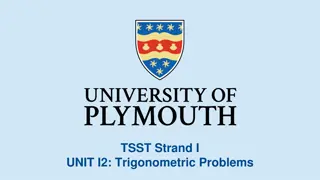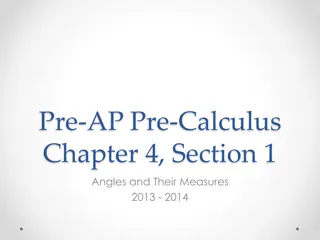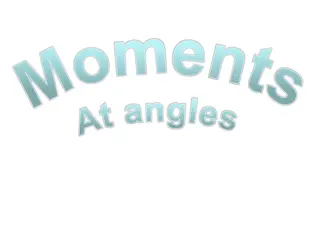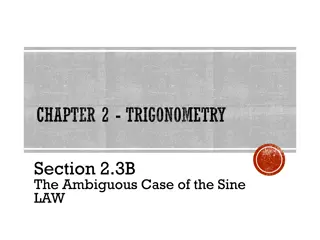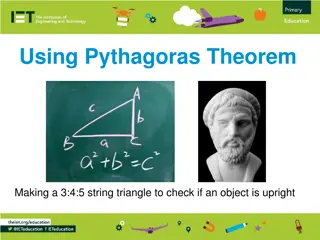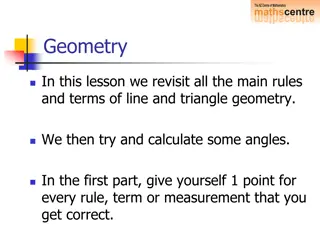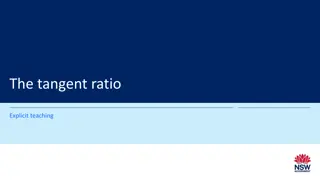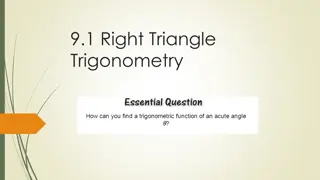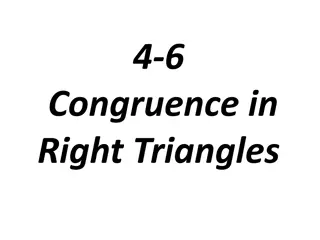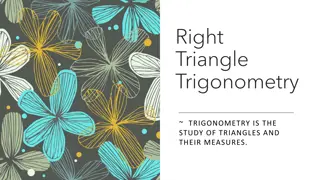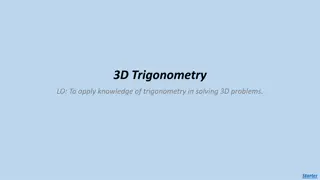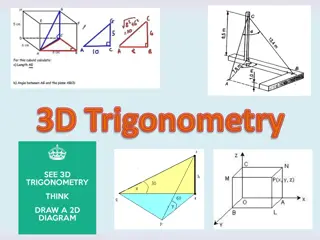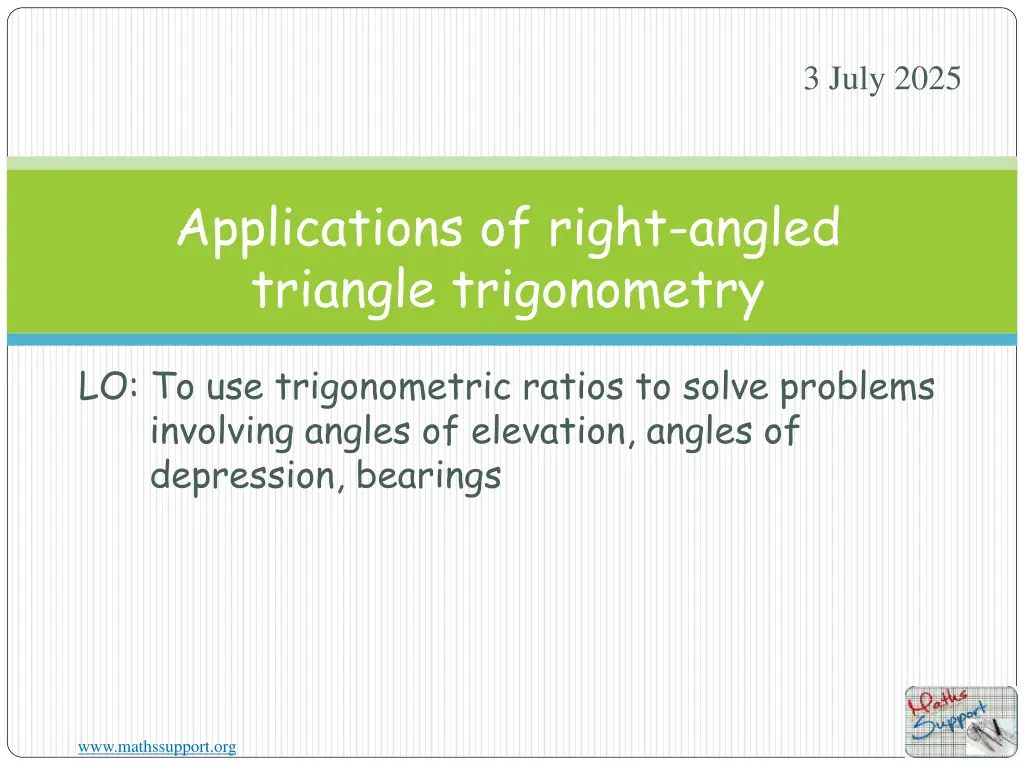
Trigonometry Applications in Problem Solving
"Learn how to apply trigonometric ratios to solve real-life problems involving angles of elevation, angles of depression, and bearings using right-angled triangle trigonometry. Understand the steps involved in problem-solving and practice with examples like calculating distances and lengths in different scenarios."
Download Presentation

Please find below an Image/Link to download the presentation.
The content on the website is provided AS IS for your information and personal use only. It may not be sold, licensed, or shared on other websites without obtaining consent from the author. If you encounter any issues during the download, it is possible that the publisher has removed the file from their server.
You are allowed to download the files provided on this website for personal or commercial use, subject to the condition that they are used lawfully. All files are the property of their respective owners.
The content on the website is provided AS IS for your information and personal use only. It may not be sold, licensed, or shared on other websites without obtaining consent from the author.
E N D
Presentation Transcript
3 July 2025 Applications of right-angled triangle trigonometry LO: To use trigonometric ratios to solve problems involving angles of elevation, angles of depression, bearings www.mathssupport.org www.mathssupport.org
Problem solving using trigonometry When problems are solved using trigonometry we follow these steps: Step 1 : Read the question carefully. Step 2 : Draw a diagram, not necessarily to scale, with the given information clearly marked. Step 3 : If necessary, label the vertices of triangles in the figure. Step 4 : State clearly any assumptions you make which enable you to use right angles triangles or properties of other geometric figures . Step 5 : Choose an appropriate trigonometric ratio and use it to generate an equation connecting the quantities. Step 6 : Solve the equations(s) to find the unknown. Step 7 : Answer the question in words. www.mathssupport.org www.mathssupport.org
Problem solving A 5 m ladder is resting against a wall. It makes an angle of 70 with the ground. What is the distance between the base of the ladder and the wall? Now label the sides First draw a sketch We are given the hypotenuse and we want to find the length of the side adjacent to the angle, so we use: cos = hypotenuse cos 70 =x 5 x = 5 cos 70 = 1.71 m (to 2 d.p.) 5 m h adjacent o 70 x a www.mathssupport.org www.mathssupport.org
Problem solving The angle between a tangent from point P to a circle and the line from P to the centre of the circle is 27o. Determine the length of the line from P to the centre of the circle if the radius is 3 cm. First draw a sketch Now label the sides We are given the opposite and we want to find the length of the hypotenuse, so we use: opposite hypotenuse 3 sin = a o 27o 3 cm C x cm h P sin 27 = x 3 x = sin 27 x = 6.61 m (to 2 d.p.) www.mathssupport.org www.mathssupport.org
Angles of elevation In this lesson we will se how to apply the trigonometric ratios to solve problems in real-life situations Angle of elevation is the angle made between the horizon and the top of an object that you are looking up at Angle of elevation Horizon www.mathssupport.org www.mathssupport.org
Angles of depression In this lesson we will se how to apply the trigonometric ratios to solve problems in real-life situations Angle of depression is the angle made between the horizon and the bottom of an object that you are looking down on Horizon Angle of depression www.mathssupport.org www.mathssupport.org
Angles of elevation Example 1 An observer stands 100 m from the base of a building. The Angle of elevation of the top of the building is 65o. How tall is the building, to the nearest metre? First draw a sketch Now label the sides We are given the adjacent side and we want to find the length of the side opposite to the angle, so we use: opposite adjacent ? 100 tan 65o = o h x tan 65o = 65o a x = 100(tan 65o ) 100 m x = 214.45 To the nearest metre it is 214 m www.mathssupport.org www.mathssupport.org
Angles of depression From a vertical cliff 80m above sea level, a boat is observed at an angle of depression of 6o. How far out the sea is the boat? Now label the sides First draw a sketch We are given the opposite side and we want to find the length of the side adjacent to the angle, so we use: x a opposite adjacent 80 ? 80 tan6 tan 6o = 6o 80 m o h tan 6o = x = x = 761.15 To the nearest metre it is 761 m www.mathssupport.org www.mathssupport.org
True Bearings www.mathssupport.org www.mathssupport.org
Compass points 45 between North and east 45 between north and west N NW NE E W SW SE 45 between south and east 45 between south and west S www.mathssupport.org www.mathssupport.org
Compass points When using Compass points for direction, you will see notation such as. N 35 E N 35 E N Which means 35 east of North 35 E W S www.mathssupport.org www.mathssupport.org
Compass points When using Compass points for direction, you will see notation such as. W 25 S N Which means 25 south of west E W 25 W 25 S S www.mathssupport.org www.mathssupport.org
Bearings Bearings are a measure of direction taken from North. If you were travelling North you would be travelling on a bearing of 000 . If you were travelling from the point P in the direction shown by the arrow then you would be travelling on a bearing of 000 . bearing of 075 . If you were travelling from the point P in the direction shown by the arrow then you would be travelling on a N Bearings are always measured clockwise from North and are written as three figures. 75 P www.mathssupport.org www.mathssupport.org
Bearings The bearing from point A to point B is 105 . What is the bearing from point B to point A? N The angle from B to A is 105 + 180 = 285 N 105 A This is called a back bearing. ? 105 B 180 www.mathssupport.org www.mathssupport.org
Bearings Two ships leave a dock at the same time. Ship A sails due north for 30 km before dropping anchor. Ship B sails on a bearing of 050 for 65 km before dropping anchor. Find the distance between the ships when they are stationary, to the nearest kilometre Sketch a diagram B C A You need to find the length AB, the distance between the ships when they are stationary There are not right angled triangles in the diagram, so draw them in sin 40o=BE 41.781 65 30 50 40 Find BE D E 65 BE = 65 sin 40o BE = 41.781 www.mathssupport.org www.mathssupport.org
Bearings Two ships leave a dock at the same time. Ship A sails due north for 30 km before dropping anchor. Ship B sails on a bearing of 050 for 65 km before dropping anchor. Find the distance between the ships when they are stationary, to the nearest kilometre Sketch a diagram B C A You need to find the length AB, the distance between the ships when they are stationary There are not right angled triangles in the diagram, so draw them in cos 40o=DE 41.781 65 30 50 40 Find DE D E 65 49.7929 DE = 65 cos 40o DE = 49.7929 www.mathssupport.org www.mathssupport.org
Bearings Two ships leave a dock at the same time. Ship A sails due north for 30 km before dropping anchor. Ship B sails on a bearing of 050 for 65 km before dropping anchor. Find the distance between the ships when they are stationary, to the nearest kilometre Sketch a diagram 49.7929 11.781 B C You need to find the length AB, the distance between the ships when they are stationary There are not right angled triangles in the diagram, so draw them in A 41.781 65 30 50 40 BC = DE = 49.7929 AC = BE - AD AC = 41.781 - 30 = 11.781 D E 49.7929 www.mathssupport.org www.mathssupport.org
Bearings Two ships leave a dock at the same time. Ship A sails due north for 30 km before dropping anchor. Ship B sails on a bearing of 050 for 65 km before dropping anchor. Find the distance between the ships when they are stationary, to the nearest kilometre Sketch a diagram 49.7929 11.781 B C You need to find the length AB, the distance between the ships when they are stationary There are not right angled triangles in the diagram, so draw them in A 41.781 65 30 50 40 AB2= (49.7929 )2 + (11.7812 )2 AB = 51.1677 The ships are approximately 52 km apart D E 49.7929 www.mathssupport.org www.mathssupport.org
Thank you for using resources from A close up of a cage Description automatically generated For more resources visit our website https://www.mathssupport.org If you have a special request, drop us an email info@mathssupport.org www.mathssupport.org www.mathssupport.org

